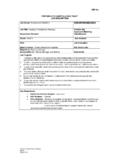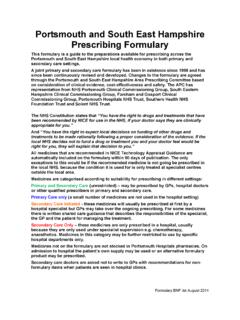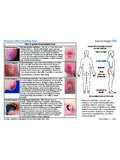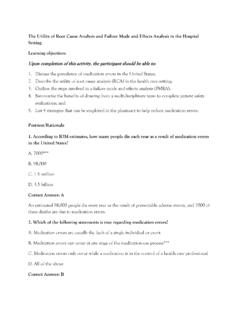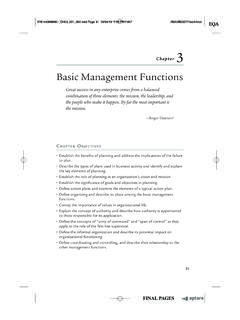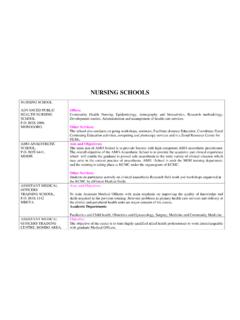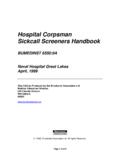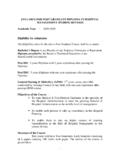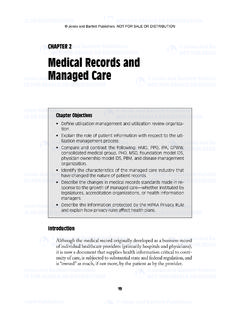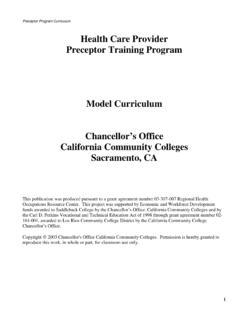Transcription of Managers Guide to Setting SMART Objectives …
1 For further information, contact Organisational Development at Page 1 Setting SMART Objectives Guidance for Appraisal Introduction why do we need to set SMART Objectives ? This guidance is intended to support appraisers and appraisees when Setting Objectives at the annual performance review and the six month review. Objective- Setting is an integral part of the appraisal process. SMART is an acronym in common use which describes the key characteristics of effective Objectives . If your Objectives are Specific, Measureable, Achievable, Relevant and Time-bound, they will enable you to focus on the aims of the team, service and the organisation as a whole and ensure that efforts are directed towards the achievement of these aims in a timely way. All too often, Objectives set during the appraisal process are less than SMART , potentially leading to a lack of focus for the appraisee and difficulties when reviewing achievements at the end of the appraisal period.
2 Portsmouth Hospitals NHS Trust s (PHT) Strategy has a set of strategic aims which should Guide the work of all services either in directly delivering outcomes (typically frontline services ) or in supporting other services to deliver (typically back office functions ) and these are as follows: Deliver safe, high quality patient centred care Develop a reputation for excellence in innovation, research and development and education in the top 20% of our peers. Become the hospital of choice for general, specialist and selected services. Be a hospital whose staff recommend the Trust as a place to work and have treatment Develop sufficient financial strengths to adapt to change and invest in the future. PHT s Strategic Aims are supported by the Clinical Service Centre Business Plans and a range of Corporate Strategies and many service Objectives will be drawn directly from these plans. In Setting appraisal Objectives , appraisers and appraisees should consider the golden thread that should be traceable from these Trust strategies all the way down to individual Objectives .
3 Writing SMART Objectives A common problem when Setting appraisal Objectives is focussing on activities, rather than on the outcome or impact of these activities. SMART Objectives focus on what it will look like when the objective is achieved. Sometimes the objective has to be achieved in a particular way and therefore should include the actions that will have to be taken in order to achieve it. However, remember that the objective should focus on the outcome. Managers Guide to Setting SMART Objectives Guidance for Appraisal Performance Reviews For further information, contact Organisational Development at Page 2 S M A R T SPECIFIC Objectives will be clear and unambiguous. They state clearly what the expected behaviour, achievement or outcome will be in precise terms. This enables you to refer back at the end of the review period and make an objective judgement about whether the objective has been achieved.
4 Consider - What is the goal? What outcome is needed? Think with the end result in Is it clear and well defined? Is it clear to anyone that has a basic knowledge of the work area? MEASURABLE Objectives enable you to see that progress is being achieved. A measurable objective will usually answer questions such as: How much? How many? How will I know when it is accomplished? What is the measurable outcome? Know if the goal is obtainable and how far away completion is. How will you know if you have been successful? ACHIEVABLE Objectives are realistic and attainable. This does not mean that you should not set stretching targets which require a change in behaviour or application of significant effort; easily achievable Objectives are not motivating. However, it is equally demotivating to set Objectives that are not possible to achieve, so consider the resources and time needed, and the potential limitations outside the control of the individual, team or service.
5 How long will it take to achieve this? Is it achievable? Agree with all parties what the goal should be to ensure clarity. Is there availability of resources, knowledge and time? Is the right support in place? RELEVANT Objectives support the team, service, or Clinical Service Centre to deliver on the Trusts priorities and strategic goals. This is where the golden thread should be visible. Consider how the individual objective supports the achievement of these wider goals. As well as Trust Strategy led aims, teams and services may also have aims and actions in relation to implementing clinical standards and regulations, codes of practice or healthcare policy recommendations in their area of work. Does the objective link to the team/department goals? Does the objective support the overall goals of the organisation? Is the objective stretching enough to ensure performance is improved? TIME-BOUND (Timescale/Timely) Objectives have clear dates, with interim milestones if necessary, for achievement.
6 Deadlines are important to focus effort on things that can get lost in day to day activity. Set a date by which the objective should be achieved, and include dates for any interim activities that are important to achieving it. What is the date for completing this objective? Is there enough time to achieve the goal or a time limit? How often will it be reviewed? Be aware of allowing too much time which can effect motivation or dilute performance. For further information, contact Organisational Development at Page 3 Tips on writing Objectives Consider how you will know when the objective is successfully achieved. Use the Personal Development Plan to record development needs, completing a course should not be an objective. Stick to 5 or 6 key Objectives Identify what it is that you want to achieve Write down what you want to achieve using a positive statement Make it specific Identify how you will measure achievement Plan the steps you need to achieve it Identify a deadline Consider how you will measure progress Use action verbs, for example; To increase To deliver To perform To identify To develop To produce To implement To draft To improve To ensure To complete To review To analyse To present To maintain Avoid woolly phrases and jargon, for example; Liaise with xxxxx why you are liaising with xxxxx?
7 What is it that the liaison will achieve? Contribute to yyyyy why is it important to contribute to yyyyy? What are you hoping to achieve? Learn about zzzzz why are you learning about it? What will you be able to do when you have learned about it? Continue to do xxxxx why do you need to continue with it? What will this achieve? Don t just restate the day job Objectives should be longer term (appraisal cycles typically look at the whole year ahead) and focus on what is new, or needs to be improved or done differently. It should not be a list of tasks, or regurgitation of the job description. Don t set too many Objectives Focus on priorities where energy and effort should be directed which are important to the achievement of the team, service and Clinical Service Centre action plans. Having too many Objectives dilutes their impact and makes it hard for you to prioritise your time. It also makes them less achievable.
8 For further information, contact Organisational Development at Page 4 This page is intentionally blank For further information, contact Organisational Development at Page 5 Examples of SMART Objectives These are examples of how to write a SMART objective, they do not profess to be technically accurate or appropriate for specific jobs but can be used as a Guide to developing your own. If you have SMART Objectives you would like to share, please send them to so they can be added to a central repository, and shared as best practice. Clinical and Non-Clinical Leadership and Management roles example Objectives Not a SMART Objective SMART Objective (Specific, Achievable, Relevant) Measure of Success (Measurable) Completion Date (Timescale) Quality X Objective: Reduce hospital acquired infections Objective: Reduce the number of patients acquiring infections whilst an inpatient, by ensuring that the service complies with hand hygiene and antibiotic prescribing regimens Infection control audits demonstrate improved compliance rates comparable to national average Number of Thrombophlebitis cases reduces to below the national average 30/12/2016 X Objective: Analyse Patient Complaints Objective.
9 By the end of February 2017, identify any concerning themes within Patient complaints and engage directly with the ward teams to agree priority changes to be made to improve the overall patient experience Number of patient complaints has reduced to below national average for peers Patient feedback and priority themes clearly displayed in ward areas Staff reporting that they feel able to contribute to improvements as reported by the National Staff Survey increased against previous year 28/02/2017 X Objective: Review SIRIs and propose learning opportunities Objective: Identify any themes from SIRI s, review and implement learning opportunities to improve the overall patient experience Reduction in number of incidents related to previous SIRI s comparable with national average Evidence of shared learning and implemented changes to practice as a result. 28/02/2017 For further information, contact Organisational Development at Page 6 Clinical and Non-Clinical Leadership and Management roles example Objectives Not a SMART Objective SMART Objective (Specific, Achievable, Relevant) Measure of Success (Measurable) Completion Date (Timescale) Standards X Objective: To reduce delayed discharge of medically fit patients Objective: To reduce the number of medically fit patients experiencing delayed discharge as a result of integrated discharge planning delays by [amount%] 100% implementation across all wards of the SAFER Patient Flow Bundle Number of patients discharged in line with targets of SAFER Patient Flow Bundle for specific ward 31/03/2017 X Objective: Ensure Constitutional Standards are met for Emergency Department performance Objective.
10 To ensure all patients awaiting care or treatment receive appropriate intervention as indicated for their condition in line with NHS Constitutional Standards Compliance with the Emergency Department 4-hour standard improves in accordance with agreed trajectory CQC standards are delivered in line with the PHT CQC Improvement Plan Improvement in patient feedback/reduction in complaints to [amount]. 30/12/2016 X Objective: Complete the review of the Theatre Utilisation project Objective: Complete the review of the Theatre Utilisation project and present report to Senior Management Team (SMT) with recommendations for actions to achieve efficiency savings, together with estimated financial savings, risk assessments and equality impact analysis Report presented to SMT by 30th September containing recommendations that are clearly outlined to enable SMT to make a decision 30/09/2016 X Objective: Work with colleagues in the Outpatient Booking team to achieve service improvements Objective.

